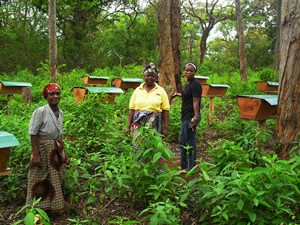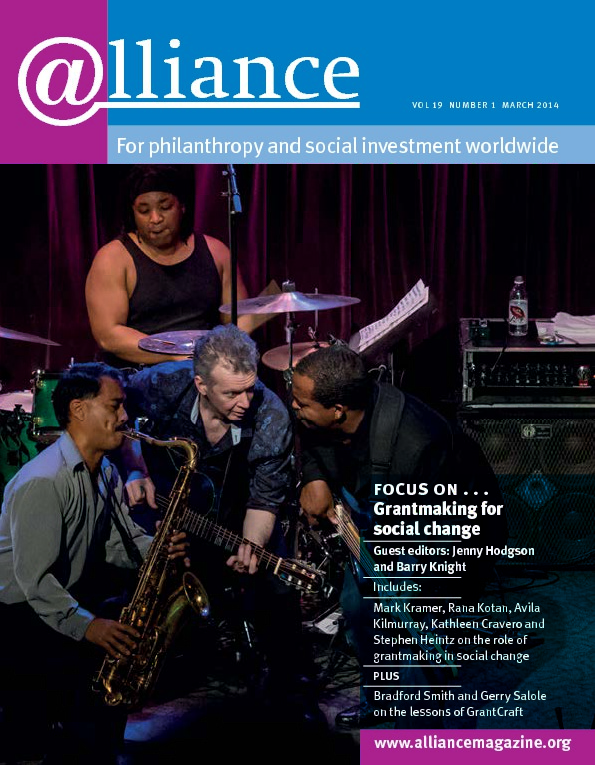In a Stanford Social Innovation Review article published in 2009,[1] Mark Kramer summed up conventional philanthropy as a process of deciding how much money to give to which non-profit – the basic transaction involved in making a grant – and stated boldly that such philanthropy will not change the status quo. He set out four principles of catalytic philanthropy, which he says is the only approach that will change the status quo, and suggests a basically top-down model for tackling complex social problems. In this article I will argue that we can embrace Kramer’s four principles without accepting the necessity for his model.
Kramer’s four principles are:
• Take responsibility for achieving results, ie get involved.
• Mobilize a campaign for change, ie get others involved.
• Use all available resources, ie don’t just make grants.
• Create actionable knowledge, ie gather and package knowledge effectively.
His model for change involves an individual philanthropist or foundation, or perhaps a corporation, taking responsibility for applying these principles in order to solve a societal problem using all resources and connections at their disposal. The focus is specific, but the aim is to build cross-sectoral alliances that can bring lasting social change.
Kramer was also at pains to defend the value of ‘conventional philanthropy’, stating that society would be worse off without the billions of philanthropic dollars but ‘we should not pretend that conventional philanthropy will change the status quo’. This is because conventional philanthropy relies on ‘supporting the underfunded, non-collaborative, and unaccountable approaches of the countless small nonprofits’. It is frustration with the slow pace of change resulting from non-profits’ work that is often a key stimulus for wealthy individuals and creative funding institutions to look for additional approaches.
This seems to me to be the crux of the matter: the symbiotic relationship between funder and NGO too often resides in a comfort zone of mutually agreed limited ambition. Here I want to take issue not with Kramer’s four principles – which seem eminently sensible – but with his conclusion that only a very particular type of philanthropist can create change on the basis of those principles. My argument is that yes, in all likelihood someone does have to put together a package of inputs and processes that chimes with the ‘four principles’ of catalytic philanthropy. However, the responsibility for putting such an approach together can rest with any one of the multiple stakeholders involved: grantmaker, NGO, investor, individual philanthropist, local entrepreneur. In addition, the approach is likely to evolve in an organic way, with different stakeholders contributing at different points.
Mozambique
Mozambique is still, despite its immense reserves of coal, gas and (probably) oil, one of the world’s poorest countries, consistently ranked in the bottom 10 in the UNDP’s Human Development Report. Only 12 per cent of the working-age population has a waged job and in rural areas the proportion is much lower. 55 per cent of the population lives below the national poverty line.
It is perhaps not surprising, therefore, that Mozambique – once described as ‘practically a laboratory for different aid approaches’[2] – continues to be something of a testing ground for different types of funding. This includes bilateral and multilateral donors contributing nearly $700 million in budget support in 2013, direct grantmaking from international foundations such as Ford and Gates, indirect funding (from ‘conventional philanthropy’) via the hundreds of international NGOs still active across the country, and hundreds of appeals for everything from bicycles to bras for onward distribution in Mozambique.
Importantly, organized local philanthropy is also emerging. Foundations such as Chissano, FDC (Foundation for Community Development), Lourdes Matola and others are supporting a wide range of mostly small-scale projects. Often these are not very ‘strategic’ grants – a water pump here, a roofed primary school there – but for the community receiving the support, they can be important grants. They can change lives, create opportunities. The extent to which real impact is achieved depends on whether or not someone – it could be the grantmaker, the implementing NGO/community group or the community – has considered longer-term issues: who will manage the facility? How will spare parts be accessed?
Perhaps inevitably, Mozambique can illustrate plenty of examples of conventional philanthropy (large- and small-scale) that is failing even within its own terms and certainly against the test of ‘creating social change’. However, across the spectrum there is much that is working. Through the following mini case-study I hope to illustrate this mix and also to test out the relevance of the four principles of catalytic philanthropy set out above.
The four principles of catalytic philanthropy: whose responsibility?
Although MICAIA started off with a relatively limited vision of a few thousand beekeepers selling honey to a local company, our vision has steadily expanded. We recognize that on our own we cannot achieve real impact; we need change and development at a value chain level. With support from the Ford Foundation we are facilitating the establishment of a National Honey Council (see case study) that will represent the interests of beekeepers, promote quality standards and good practice in beekeeping, and promote honey consumption. We’re also bringing many stakeholders together, including government, to put in place measures that will open up export opportunities to the EU and elsewhere.
I cannot claim that we alone have taken responsibility for creating social change through the honey value chain, but we are at the heart of a small group of organizations and investors willing to do so. We are certainly getting others involved, steadily building a multi-stakeholder group working on all elements of the value chain. We are using all available resources, mobilizing investment to match grants. A few years into the work we are also now starting to learn, and through the Council we should be able to share that learning, ie to create actionable knowledge.
While Mark Kramer’s ‘four principles’ do seem to be observed here, this is certainly not the top-down designed and individually driven ‘model’ he so often presents. Instead, it has evolved from the bottom up.
Conclusion
There is no doubt in my mind that large-scale social change needs all possible resources to be brought to bear. In Mozambique we see every shape and size of philanthropic gift and all types of investment. Could more be achieved with these resources? Undoubtedly. The fact is that Kramer’s critique of the relationship between conventional philanthropy and non-profits does have resonance in Mozambique.
There needs to be a symbiotic relationship between NGO and donor; we need each other. When that relationship is creative, mutually challenging, collaborative and outward-looking, it can be dynamic and can achieve impact within and beyond the scope of a single grant. Even the smallest grantmaker can challenge (through its guidelines and evaluation processes) potential grantees to consider how a small grant will create change and how that change will be sustained.
Sadly, I do feel that too often the relationship between grantmaker and NGO is essentially limiting. NGOs that rely on subsidy so easily become opportunistic and willing collaborators with any grantmaker that will give them money. We are risk-averse and timid in the face of ‘powerful’ donors. If we take the path of least resistance, then busy grantmakers with big portfolios cannot be expected to change tack.
The point is, however, that change can be fostered and facilitated by any one of donor, grantmaker, investor, entrepreneur or NGO. In the case of honey in central Mozambique, the coalition of interested parties brought together largely by MICAIA now includes grantmakers, investment funds, government agencies, private sector support consultancies, a social enterprise and several NGOs.
There is nothing wrong with Mark Kramer’s ‘four principles’ of what he terms ‘catalytic philanthropy’. He has presented an array of excellent examples of the principles being applied. But his leap from illustrating four sound principles to making grand claims for a new ‘model’ is a step too far.
Someone or some coalition of interests does need to think strategically and creatively about how to create lasting change in any given situation but why should we assume that this has to be an inspired philanthropist rather than a thoughtful NGO or a good grantmaker?
Certainly, working in isolation is rarely going to bring change, but a glance at the thousands of sector-wide multi-stakeholder initiatives established in health, education, environment and livelihoods in just the countries in which I have worked over the last 20 years suggests to me that building campaigns around an issue is an established strategy, and that many grantmakers and NGOs are active in building them. Especially as scale increases and certainly in dealing with livelihoods, we often need to match grants with different forms of financial support. Finally, creating ‘actionable knowledge’ is a core part of most good NGOs’ work and is supported by most good grantmakers.
Mark Kramer’s efforts on catalytic philanthropy are to be welcomed not because they present a breakthrough model but because they remind us all of some essential building blocks of working for social change.
1 Mark Kramer, ‘Catalytic philanthropy’, SSIR, Fall 2009.
2 Sarah Lucas (2005) Mozambique Field Report, Centre for Global Development.
3 Other examples of social and ‘impact’ investors active in Mozambique include the Grassroots Business Fund, SNS Impact Investing and Soros Economic Development Fund.
Andrew Kingman is co-founder of MICAIA. Email andrew@micaia.org
Case Study: Mozambique Honey Company
Like bees around a honey pot … building the honey value chain
Why beekeeping?
 Supporting beekeeping has long been popular with donors and NGOs alike. It ticks many boxes: it can generate a livelihood; it’s good for the environment; it builds on traditional practices but introduces ‘appropriate’ technology. Mozambique has excellent potential for honey production and currently there are multiple efforts to expand it.
Supporting beekeeping has long been popular with donors and NGOs alike. It ticks many boxes: it can generate a livelihood; it’s good for the environment; it builds on traditional practices but introduces ‘appropriate’ technology. Mozambique has excellent potential for honey production and currently there are multiple efforts to expand it.
If a market for honey is established, there’s no doubt that beekeeping can create social change. In our own work with beekeepers I look at the experience of people such as Mrs Quiteira Filipe. She’s earning enough from the sale of honey to send her children to school and to hire labour to work in her fields, and she is now the (highly effective) president of her local group of women beekeepers, all of whom have new status and opportunities for personal development. (Pictured: Mrs Quiteira Filipe, president of her local group of women beekeepers, in her apiary)
Efforts to date
Most are small-scale and delinked from the market and unlikely to achieve a great deal. One Canadian-funded project has supplied 50 beekeepers with modern frame hives but not with the equipment to extract the honey. A local mission has the support of a family foundation in the US that is very keen on beekeeping. Unfortunately, the community where the mission works is very dry with few trees. No problem: trees will be planted and wells dug. Over time that project might just enable one community to gain a little income from beekeeping, but only if a market can be found. At a much larger scale, in 2012-13 the World Bank funded an initiative in the central region to supply 14,000 top-bar beehives and other equipment to around 1,000 beekeepers, some of whom also received training. The grant (around $1 million) paid no attention to the market and ignored the fact that honey in the area has a high humidity – which means that it ferments in the bottle.
MICAIA’s approach
MICAIA has been involved with honey since 2010. Using part of a grant from Fundaçao Gulbenkian focused on training and learning, we co-organized a meeting of stakeholders in the honey sector in central Mozambique. That meeting led to agreement between MICAIA, Dutch development organization SNV and local businessman Andre Vonk to work together to establish what would become the Mozambique Honey Company. Soon after, SNV and MICAIA secured a small grant locally to train beekeeper trainers.
Meanwhile, outside of any project framework, MICAIA continued to help plan the potential business. Vonk agreed to set up the company on inclusive terms, with beekeepers holding 45 per cent. However, he challenged MICAIA to take responsibility for working with beekeepers to establish the organizational capacity to hold those shares collectively. We agreed. Eco-MICAIA Ltd, the social enterprise part of the MICAIA ‘family’, became a founding shareholder in the Mozambique Honey Company (MHC) and facilitated development of a Union of Beekeepers to which 45 per cent of shares would be transferred.
While Andre Vonk started investing in the business, MICAIA set about fundraising. Today, with grant funding from Comic Relief and the UK’s Department for International Development, our non-profit foundation (MICAIA Foundation) is supporting 2,250 beekeepers (including 800 women) to make beekeeping an important part of their livelihood. We facilitate training and organizational development as well as subsidized, credit-based access to equipment. Although the Comic Relief grant focuses on building the individual and organizational capacity of beekeepers, it was clear that for them the emergence of a commercial company and its inclusive nature was critical. In addition to these larger grants, MHC and the development of beekeeping in the central region have benefited from several small-scale pieces of targeted funding for technical support and consulting inputs to the business development process.
Use 54-55 MHC honey somewhere near here
The role of impact investing
The development of MHC has been greatly aided by another feature of the funding landscape in Mozambique today, the involvement of social and ‘impact’ investors,[3] including the Africa Agricultural Development Company. AgDevCo provides patient capital and extensive technical support for agricultural SMEs. MHC approached AgDevCo in 2011 and on the basis of an agreed expansion plan to date some $250,000 has been invested in the honey business. The result is the first honey trading company in Mozambique capable of producing high-quality honey packed for the formal market and sold throughout the country. The scale of private investment has meant a significant reduction in shareholding for the beekeepers, but they still own 8 per cent of the company through their union. This holding could increase once debt in the business has been repaid, because impact investors like AgDevCo are not seeking to maximize profit but rather to recover capital with a reasonable return while maximizing benefits for producers.
Comment Mark Kramer
 Andrew Kingman’s inspiring example of economic development in Mozambique does indeed embody the principles of catalytic philanthropy, as well as many aspects of our more recent research on collective impact and emergent strategy. In fact, Mr Kingman and I agree on almost everything in his article, and I am very encouraged that someone with his depth of experience on the ground sees the merit of my approach.
Andrew Kingman’s inspiring example of economic development in Mozambique does indeed embody the principles of catalytic philanthropy, as well as many aspects of our more recent research on collective impact and emergent strategy. In fact, Mr Kingman and I agree on almost everything in his article, and I am very encouraged that someone with his depth of experience on the ground sees the merit of my approach.
Mr Kingman does level three criticisms, however. First, he takes my article to suggest that only philanthropists can lead change. I see how it could be read that way: I was writing a critique of philanthropy for philanthropists, and omitted any discussion about other leaders of social change. But I wholeheartedly agree that many different individuals and types of organizations other than philanthropists can lead change and, in fact, do so much more often. The only difference between a social entrepreneur and a catalytic donor is that the donor already has the money that the social entrepreneur needs to raise. But when it comes to acting as an agent of social change, the steps are similar regardless of the position from which one begins, and donors certainly do not need to be the ones to lead the way.
Second, Mr Kingman suggests that my approach to change is based on a ‘top-down’ model. Here, however, I did try to be clear in writing:
‘Catalytic philanthropists . . . must be as cautious as they are bold . . . Philanthropists cannot catalyze change by acting alone or imposing a solution, convinced that they have the answer before they begin. Instead, they must listen to and work with others, enabling stakeholders to develop their own solutions. . . .
‘Social change is a messy process in which the willpower of a determined and influential person can often tip the balance. Donors who are serious about solving social problems must . . . [knit] together the pieces of a solution in ways the fragmented nonprofit sector cannot do for itself.’
All social change requires great leadership, just as it took leadership from Mr Kingman to knit together a solution for beekeeping in Mozambique. But great leadership is never the same as imposing a top-down model.
Finally, Mr Kingman suggests that the principles of catalytic philanthropy are not new. I have not seen these four elements previously brought together in the same way. However, I readily concede that many great philanthropists have used these elements long before I wrote about them. All of my writing aims to distil effective practices into simple frameworks that can guide others in how to achieve greater impact. I have never claimed to invent those effective practices, only to codify and inspire others to adopt them. If my approach comes to Mr Kingman not as a ‘breakthrough model’ but as a reminder of ‘essential building blocks of . . . social change’, that’s good enough for me.
Mark Kramer is managing director of FSG. Email Mark.Kramer@fsg.org






Comments (0)